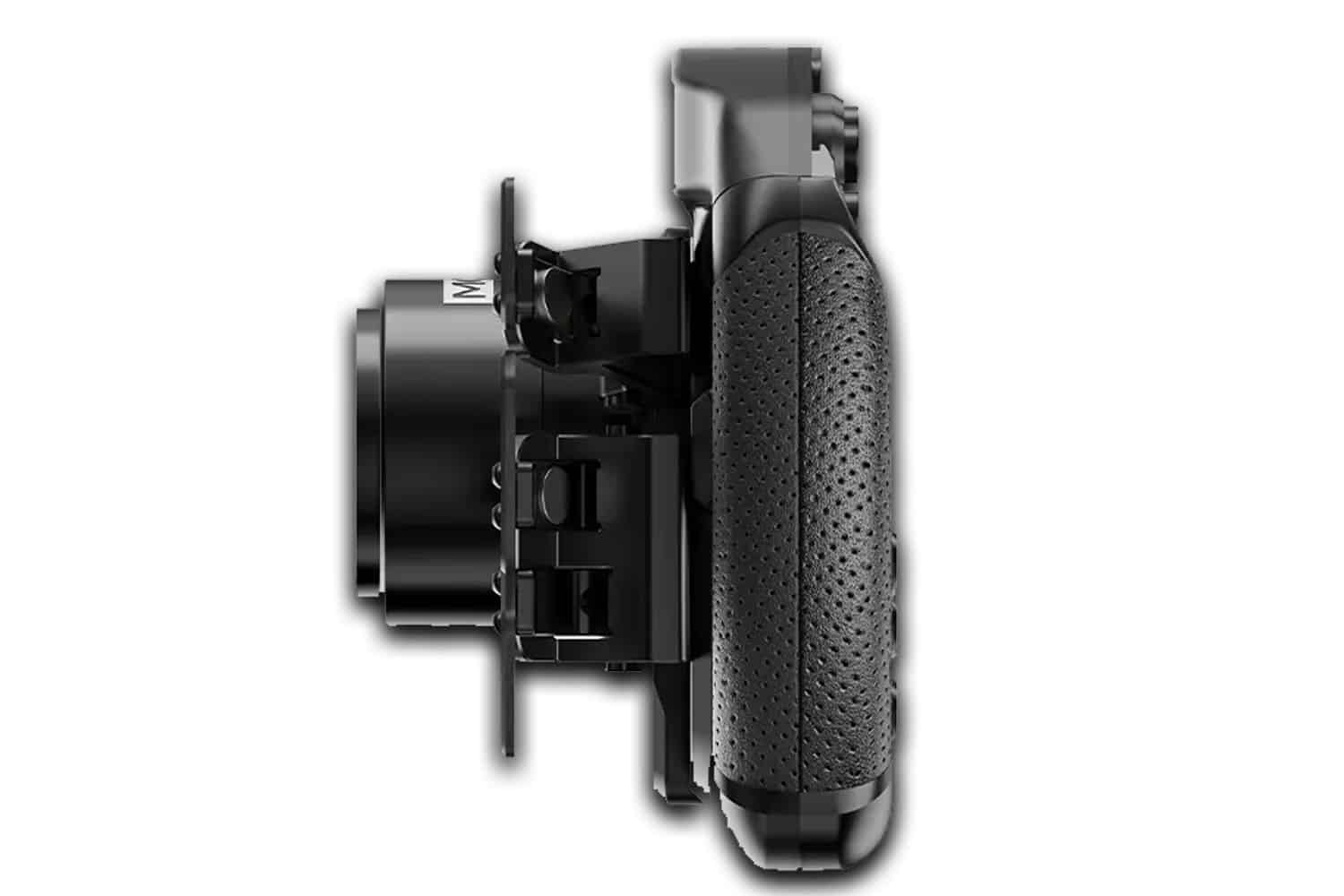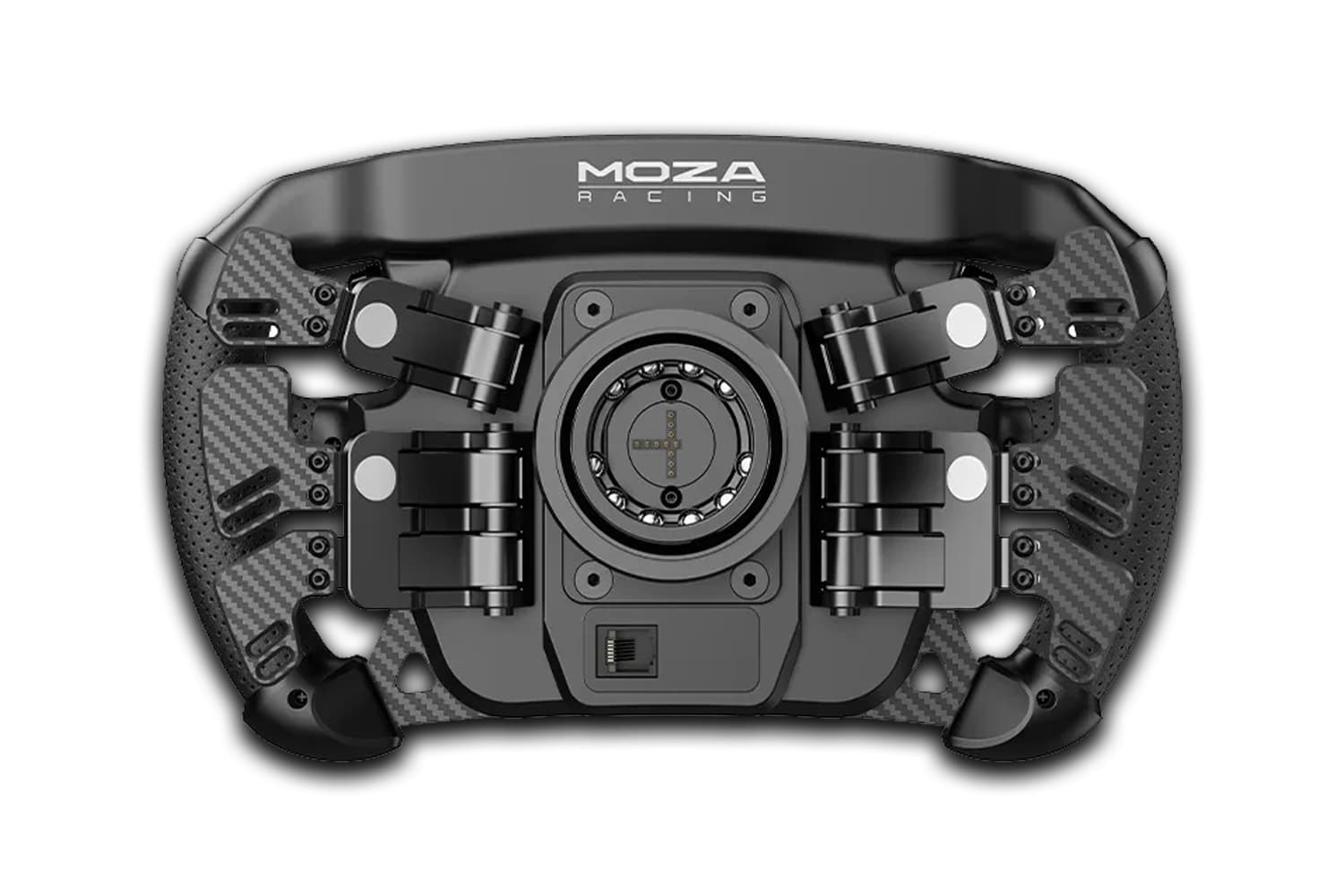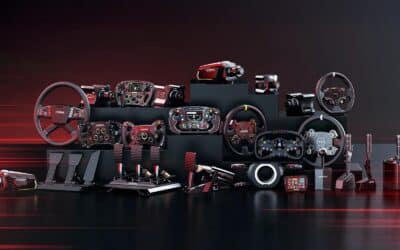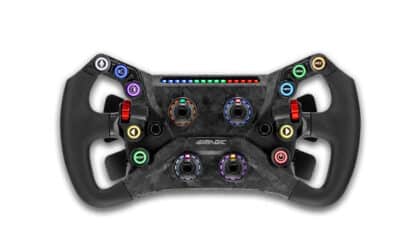Moza FSR2
Benefits
- Carbon fiber faceplate
- Good build quality
- Large, central touchscreen
- 6 rear paddles
Disadvantages
- Virtually identical design to the FSR it replaces
- Textured leatherette handle
Our rating : 9.7/10
Moza Racing , a manufacturer of sim-racing peripherals, has been in the industry for a few years, but has managed to carve out a place for itself on the global market. The key to its success: offering quality, high-performance products at attractive prices. And so far, it’s worked.
The brand boasts a complete catalog of peripherals, capable of satisfying both beginners and the most seasoned pilots in the discipline. From steering wheels and Direct Drive bases to pedalboards (including an active one in Simucube sauce) and a complete flight-sim range, Moza has become a key player on the world simulation scene.
Moza’s latest additions include an F1-style wheel to replace the FSR, simply called the FSR2. This wheel represents the brand’s top of the range, and it just so happens that we’ve got it on our Sim-Racing setup to see what it brings to the table compared with the one it replaces.
Main and technical features of the steering wheel
- Carbon fiber faceplate and aluminum alloy frame
- 4.3″ central color touch screen
- RevLED on screen top and sides
- 19 front panel controls with buttons, switches, rotary encoders and funky switches
- 6 rear paddles, 4 magnetic and 2 progressive
- Perforated leatherette handles
- 28 cm diameter with rectangular shape
- Moza QR on the rear, derived from the D1-Spec
- Compatible with all the brand’s modern bases
- PC compatible only
Design
If you’ve already had your hands on the Moza FSR, you’ll notice that the FSR2 is virtually identical to the one it replaces. Apart from the screen, which no longer has edges, the 6 rear paddles instead of 4, and the appearance of RevLEDs on the sides of the screen, which can be configured to display flags, for example, the FSR2 is a carbon copy of the FSR.
The faceplate is still carbon fiber, with an aluminum-alloy back-plate structure. The perforated leatherette grips are quite handsome, with a 09H15 riding position. As the Americans say, “if it ain’t broke, don’t fix it”, and Moza has taken that to heart.
The FRS2 is still a fine steering wheel, as is the FSR, with just a few more technical improvements.
Customized assembly
At the rear of this steering wheel is Moza’s famous QR, developed in partnership with Simagic and derived from the D1-Spec found in motor racing.
The FSR2 can be fitted to all the latest Moza bases, at least those with the revised QR, and the operation is very simple. Simply pull the ring, align the QRs (flywheel and chainstay), insert the wheel and release the QR. It’s simple, effective and, above all, there’s no risk of damaging your equipment.
Manufacturing and finishing
Since the FSR2 is not really a revolution compared to the steering wheel it replaces, Moza has used the same materials on its new wheel. The structure is made of an aluminum alloy derived from the aeronautics industry, with a carbon fiber faceplate. On the grips, Moza has used imitation leather of fairly good quality, although I would have liked to see real leather, or alcantara, as this wheel is rather expensive.
In terms of finish, the FSR2 is a premium steering wheel in every respect. The wheel is made up of just a few components, and all the parts fit together perfectly. There’s very little plastic on the wheel, which enhances the FSR2’s premium feel.
And when it comes to build quality, once again, it’s premium. Moza has a good deal of experience in the game, and virtually all its wheels are of high quality. The FSR2 is no exception to this rule, as are the wheels from Fanatec, a direct competitor of Moza.
Handling the steering wheel
Let’s get to grips with this steering wheel. Once again, we find ourselves with a slight evolution from the FSR, and the resulting grip is just as good as on the steering wheel the FSR2 replaces.
First of all, you can use this steering wheel with or without gloves, and this choice will have no impact on the FSR2’s handling. As for the buttons, they are easily accessible without your hands leaving the handles. All those on the front are close to your thumbs, as well as being very tactile, with a good feel.
The rotary encoders, too, are easy to use, turning superbly at full travel, with no catchy feel. But this doesn’t necessarily apply to the two thumbwheels, which can sometimes be too soft, or too hard. But hey, that’s the way it was before, and we find ourselves in a situation where there’s nothing new.
Let’s finish with the grips, screen and paddles. For the former, the driving position, as well as the comfort when racing, is just excellent. And the first new feature of the FSR2 is the 6 rear-mounted paddles, which fit perfectly under your fingers. As for the screen, it’s now touch-sensitive, high-resolution and virtually borderless.
Sensations during play
Let’s move on to the feel of Moza’s new FRS2. The big change you’ll feel with this steering wheel is the addition of 2 extra paddles at the rear. Instead of 2 magnetic paddles, you now have 4, plus 2 progressive ones. You’ll be able to use them in a much more versatile way in Formula, or even endurance racing, and that’s a big plus compared to the steering wheel it replaces.
As for the rest, there’s not much difference between the two wheels. The 09H15-style riding position is as comfortable as ever, even on long sim-racing sessions. Buttons are easily accessed from the grips, without your hands leaving their place. The structure is very solid, showing no flex even with a base that swings a lot of torque, like the
As far as the screen is concerned, there are virtually no edges, and the addition of a touchscreen for your own enjoyment. On that note, and if you’re riding with gloves, it’s best to have a pair designed to work with touch screens.
Once again, FSR2 builds on the solid foundations of its predecessor, with the addition of minor enhancements that make for a far more realistic experience.
Compatibility
Not surprisingly, the FSR2 remains compatible with all Moza Racing bases, and only on the PC platform. Virtually all the manufacturer’s range is like this, and it doesn’t really change our habits.
However, you can use this steering wheel on a Direct Drive base other than Moza’s via a hub that the brand makes available for around 50 euros. You’ll have the hub for direct connection to the PC, as well as other brand peripherals. You’ll also have the QR to attach Moza’s base and steering wheel.
Value for money
The FSR2 is priced at €699, exactly the same as the steering wheel it replaces. And that’s a very good thing, I think, to sell an improved version of a product at the same price as the one it replaces.
In terms of value for money, it’s very good compared with the competition. With the FSR2, Moza now offers a wheel capable of taking on Simagic’s FX Pro on its own turf, while being slightly less expensive.
My verdict
Moza has once again demonstrated that the brand is here to win market share. The FSR2 represents a slight evolution from the FSR, with the addition of elements that make all the difference on the track and, above all, against the competition. If you don’t have an F1-style steering wheel, then you can take the FSR2 without hesitation, especially if the Moza ecosystem has already won you over.
But if you’re thinking of swapping your FSR for version 2, I think you’d better wait until the price drops a little before pulling out the blue card.







0 Comments